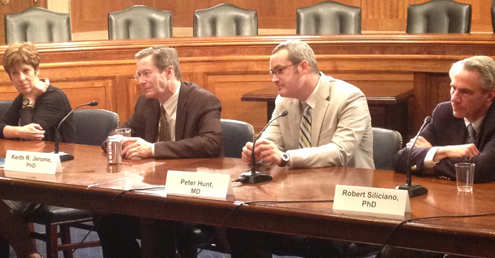“Eradicating AIDS and finding a cure is the moonshot of our
generation,” said Dr. Susan Blumenthal, Senior Policy and Medical Advisor at
amfAR and Former U.S. Assistant Surgeon General, who organized and moderated an
amfAR-sponsored Capitol Hill briefing on HIV cure research in Washington, D.C.,
this summer.
With these words, Dr. Blumenthal brought to a close an engrossing
program that had begun with renowned broadcast journalist Judy Woodruff
interviewing Timothy Brown, the “Berlin Patient,” the first and only person
known to be cured of HIV. While on
treatment for HIV, Brown was diagnosed with leukemia in 2006. For the stem-cell
transplant he needed, his physician, Dr. Gero Hütter, was able to locate a
donor among the one percent of people born with a genetic mutation making them
resistant to HIV. People in this group lack the CCR5 receptor, which is the
primary means by which most strains of HIV infect cells.

Dr. Paula Cannon, Dr. Keith R. Jerome, Dr. Peter Hunt, and Dr. Robert Siliciano at the U.S. Senate.
Following the transplant, Mr.
Brown was able to stop HIV treatment without experiencing a return of his HIV and he no longer tests positive for the virus. His case provides the first
proof of concept for a cure for HIV and has been the impetus for scientists and
donors to begin working together toward a research goal once thought
impossible.
amfAR has been funding cure research for more than a decade,
and in 2010 launched the amfAR Research Consortium on HIV Eradication
(ARCHE). As Dr. Rowena Johnston, the
Foundation’s Vice President and Director of Research, said during the briefing,
“We will leave no stone unturned. The
strength of the amfAR model is to bring researchers together to exchange
ideas.” amfAR announced another set of ARCHE grants in June.
During the briefing a panel of four scientists discussed
their research. Three-time ARCHE
grantee, Dr. Robert Siliciano of Johns Hopkins
University School of Medicine, is studying ways to force latent HIV that is lying dormant in cells, to become active so that it can be targeted by
antiretroviral therapy. Dr. Siliciano
has already identified several drugs that could potentially be used to
reactivate latent virus and is looking for additional, more powerful options.
Dr. Keith Jerome of the Fred Hutchinson Cancer Research
Center in Seattle is working to perfect a technique called gene editing, which
uses an enzyme to find and remove the genetic sequence of HIV that has inserted
itself into a cell’s own DNA or the protein it uses to enter the cell, leaving
the cell HIV free. “What we need,” he
said, “are enzymes that cleave what we want.”

POZ Editor in Chief and amfAR Board Member Regan Hofmann, Dr. Paula Cannon, and Timothy Brown, the “Berlin Patient” at the U.S. Senate.
Some elements of the immune system’s response to HIV, Dr.
Peter Hunt of the University of California in San Francisco, explained, lead to
detrimental effects on the heart and other organs as it wears them out
prematurely, leading to chronic conditions such as heart disease. He
theorizes that we need to find ways to modulate the immune system’s response to
HIV so that it can both delay the onset of AIDS, as well as minimize the side
effects of an overly active immune system.
Dr. Paula Cannon, of the Keck School of Medicine of the
University of Southern California, is leading efforts to eliminate HIV from the
body by removing the CCR5 receptor from a patient’s own stem cells. Without this receptor the virus can no longer
infect cells and dies off.
The second half of the briefing shed light on the policy
aspects of HIV/AIDS research. Dr. Carl W. Dieffenbach, director of the Division of AIDS at the National
Institute of Allergy and Infectious Diseases at the National Institutes of
Health, said that proper investments in research now will pay off in the future
– and could change the course of the epidemic. “Ultimately, through a
vaccine and cure, we will really begin to create an AIDS-free generation,” he
said.
Regan Hofmann,
editor of POZ magazine and an amfAR
trustee, also urged policymakers to seize on recent scientific advancements
now. “We don’t want to give
false hope, but those who understand the science understand that we are
there. This is our moment.”
Dr. Jerome Zack of the UCLA Center for AIDS
Research and Chris Collins, amfAR’s Vice President and Director of Public
Policy, discussed the issue of funding for cure research. Support for
scientific research in general is threatened.
Last year, when a bipartisan Congressional committee failed to agree on
a plan to achieve $1.2 trillion in deficit reductions an enforcement mechanism was
triggered that will result in across-the-board spending cuts via sequestration.
Unless it is voted down by Congress this fall, sequestration
will take $300 million out of AIDS research by flat-funding the National
Institutes of Health. “If this were a
business,” said Collins, “now is not the time to divest.”